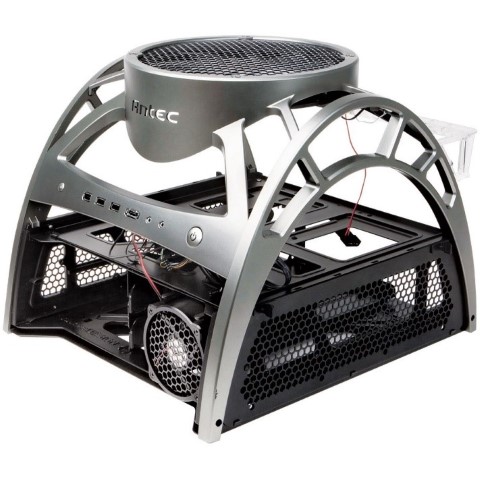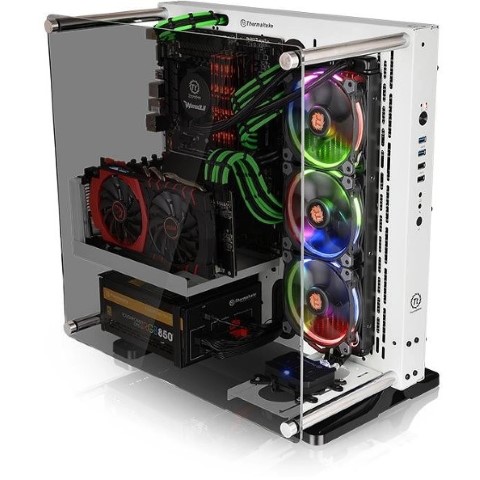
The use of open air builds has been around for a long time, I would say likely since the first home built PCs and even before. In the early days an open air build was done for one of two reasons. Either you had no money for a case so you let the parts kind of hang out until you could get a case or you built a test bench to allow for quick part swapping. Today open air builds are much more common and have become a niche in a build community all unto themselves.
First let’s discuss the PC case. The basic purpose of the case is to provide an enclosure to keep your PC parts protected. The enclosure however creates a bit of an issue with heat building up, so the need to add fans and create directed airflow exists.
In the early days of computers this was vital as the systems tended to be big, this meant they were put on the floor and were prone to be accidentally kicked or having animals in the home near them all the time. A level of protection for the components was needed.
The case today has become something more, with people using them as show cases for their PC components with small light shows and other methods to individualize their builds. Also with case design, air flow has become a bigger deal with various different approaches to keep the PC components cool.
This is where open air design comes in. The basic principle of an open air build is to not enclose the PC. You have a basic framework that the components rest on (sometimes) and then you leave the build open. While test benches are still widely used this has developed into its own market with open air builds ranging from using a motherboard box, to building a frame work out of wood or even buying custom made open air frames. One of the first commercial attempts at an open air frame was around 2008 with the Antec Skeleton. Today many different frames and designs are offered ranging in size from SFF to full ATX custom loops.
Why would you want to build an open air case? I mean we know a case is there to protect your PC right? Well as we have advanced, the size of the PC has come down quite a bit. SFF PCs are not much bigger than a shoe box and even larger ATX builds can be made fairly compact. This means the build can now be on a desk, away from stretching legs and wandering dogs. (More on cats in a bit) Open air offers a few advantages and disadvantages over a traditional case as well as there being a few myths and misconceptions. Lets dive in…..
So let me explain what I mean by thermal mass. When you enclose an area you have the air within that space to work with. As heat is applied that air begins to heat up and since it is enclosed the heat is mostly applied to that area directly. With a computer case we use fans to move in cooler air and exhaust the warmer air but at some point the fans are not moving the air fast enough and the heat begins to build up. Now with an open air frame the air that is heating is the entire room, or possible the entire house. This means the heat is dissipated over a much wider area. Think of it this way. Take a pot of room temp water and now pour a cup of boiling water into the pot. The pots temp rises. Now keep doing that and it will not be long before you have a pot of hot water. Now take a swimming pool of room temp water and pour in the cup of boiling water, the temperature change will take a lot longer and a lot more effort. The result is open air designs, in general offer better cooling.
Now with better cooling comes a fun side benefit, lower noise. I have had some people argue that a case will snuffle some of the noise so the case would be a quieter build, and to some extent this is true. However, in general lower temps means lower fan speeds. Also consider that not only will you have potentially lower fan speeds, you will also have fewer fans. A case needs a number of fans to move air around for cooling. An open air design does not need these, thus fewer fans to make noise. (Not to mention fewer fans means a cost savings)
What about the current trend of using your PC as a show piece? Well what better way is there to show off your build than having the parts open and visible? No glass panels to get scratched or dirty, plus no restriction to air flow?
Yeah but you mentioned dirty, open air frames means more dust…. Does it? Well in theory yes it does. However, lets explore that a bit. So, cases are often touted for their ability to have dust filters. In my own experience dust filters are not nearly as great an idea as they sound. First most dust filters barely stop any dust. You all know what I am talking about, even with filters PCs still need to be opened and cleaned. However, there is another side to this argument. A GOOD dust filter restricts air flow, some can cut the ability of a fan to move air by 20% or so. This means with the dust filter in place (a good filter) you need to increase fan speed for the same air flow and thus increase noise. Oh, wait there is more. A good filter will become clogged fairly quickly and this will further impede air flow. So, you start with limiting air flow a little but as the computer is used that air flow limitation gets worse. My own experience has led me to removing filters and just cleaning more often with my case builds. It allows for a quieter and cooler system.
What has this to do however with open air frames and dust? Well, a few things, the case traps some of the dust inside it and can actually build dust a little faster than an open air frame. Also an open air frame is ridiculously easier to clean. I had someone at an event challenge me on this. I had them take a can of compressed air and told them to clean their PC while I timed them. The total time for cleaning, which meant opening the case, cleaning the filters, cleaning the PC, putting back in the filters and closing the case, took around 3 minutes and he was hustling. We then walked over to my open air frame. I turned off the PC and 15 seconds later was ready to turn it back on. As I pointed out then, I clean my Xproto based build about once a month. Even if he cleaned his PC once a year we would only be about EQUAL to our total time cleaning.
Finally, there is maintenance in general. Open air frames are much easier to get to and work on or swap out parts. This is after all the same build concept of a test bench.
So better cooling and possibly quieter, fewerless fans, showings off all the parts, easier to clean and maintain; this all sounds pretty good, there are some downsides.
Open air frames can cost more than cases in some instances. Now frames like the Thermaltake Core series are pretty reasonably priced but you can get into the weeds with prices. The Xproto frame I like to use can set you back close to $200 before your done.
Open air frames also can require more effort for a “clean” build. Cable management can be as difficult and even more so than SFF builds. With the Xproto I mention I buy custom made cables to make them easier to hide.
If you have cats, then an Open Air frame can have some issues. Cats like to run up against stuff, especially if it is warm. I have actually seen where a cat bumped an open air build off the desk. If you travel a lot with your PC then an open air build can create some special needs to transporting. Since I drive myself to events I can carry my Xproto build in a sewing machine bag with no issues. But if you fly or travel a lot then proper protective case like a Pelican makes a lot of sense.
In the end then, is an Open Air Build better than a case? No, I do not think one is especially better than the other in overall consideration. Each has aspects that appeal to many people, and each has it’s pros and it’s cons. In the end the choice is personal. For me, I love the geeky feel and look of a SFF open air build. You might enjoy the look of a big tower sitting under your desk. Either is a great option as we still share the common ground of loving to build our PCs.
The articles content, opinions, beliefs and viewpoints expressed in SAPPHIRE NATION are the authors’ own and do not necessarily represent official policy or position of SAPPHIRE Technology.





















